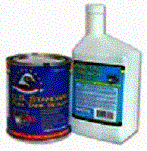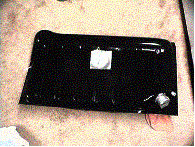Fuel Tank Restoration
By: Glenn Ring
 Sooner or later you will need to replace the gas tank in your
Volkswagen. Over time water collects inside, from bad gas or condensation, and
will rust the tank from the inside out. You will notice the smell of fuel when
you fill the tank or make turns. If the tank is beyond repair, with numerous
pin holes or larger rust holes, it will have to be replaced. All the
aftermarket tanks are of poor quality and are rather generic. That means you
might have modify them to “make” it fit. Another alternative is to find a used
tank, but you might be in the same boat again in a few years.
Sooner or later you will need to replace the gas tank in your
Volkswagen. Over time water collects inside, from bad gas or condensation, and
will rust the tank from the inside out. You will notice the smell of fuel when
you fill the tank or make turns. If the tank is beyond repair, with numerous
pin holes or larger rust holes, it will have to be replaced. All the
aftermarket tanks are of poor quality and are rather generic. That means you
might have modify them to “make” it fit. Another alternative is to find a used
tank, but you might be in the same boat again in a few years.
If you want to save the tank before there is a
problem or if you are replacing it with a used tank, you should take the time
and apply a sealer. I recently restored a tank using a product form POR 15
(http://www.por15.com). For those who don’t know POR 15 has an entire line of
rust repair paints and are well known in the vintage car community. I decided
to use their “US Standard Fuel Tank Sealer”.
After draining all the fuel I removed the tank.
There was some rust on the inside so I took it to a local radiator shop to have
it “boiled”. That is a process of submerging the tank in a acid solution and
removing any loose rust, sludge and gummy build up. The tank comes out nice and
clean on the inside.
I wanted the tank powder painted so this was the
time to do it. If I did it after sealing the inside the heat of the curing
ovens would damage the sealer. If you are painting it with spray cans or a
brush, you can do it after sealing the tank.
 POR 15 sells a special prep called “Metal Ready” that needs to be
applied before the sealer. It etches the metal and leaves a zinc phosphate
coating. You need to close all the openings, except the sender opening, with
duct tape. Then pour in the Metal Ready and tape the sender opening also. Now
you slowly rotate the tank, making sure the liquid coats the entire inside.
Back and forth, side to side and upside down. After about 30 minutes you drain
the metal ready and wash the inside with warm water. Drain the water and use a
hair dryer to totally dry the inside.
POR 15 sells a special prep called “Metal Ready” that needs to be
applied before the sealer. It etches the metal and leaves a zinc phosphate
coating. You need to close all the openings, except the sender opening, with
duct tape. Then pour in the Metal Ready and tape the sender opening also. Now
you slowly rotate the tank, making sure the liquid coats the entire inside.
Back and forth, side to side and upside down. After about 30 minutes you drain
the metal ready and wash the inside with warm water. Drain the water and use a
hair dryer to totally dry the inside.
Now you are ready to apply the sealer. You have to
tape closed all the openings again and pour in the sealer. Again you need to
rotate the tank, making sure the entire inside surface is coated. After a few
minutes you drain the sealer. Leave the tank for an hour or two to make sure
all the sealer drains out. It takes a
few hours for the sealer to harden and 96 hours for it to fully cure.
Now the tank is ready to be reinstalled. It should
last for another 30 years.